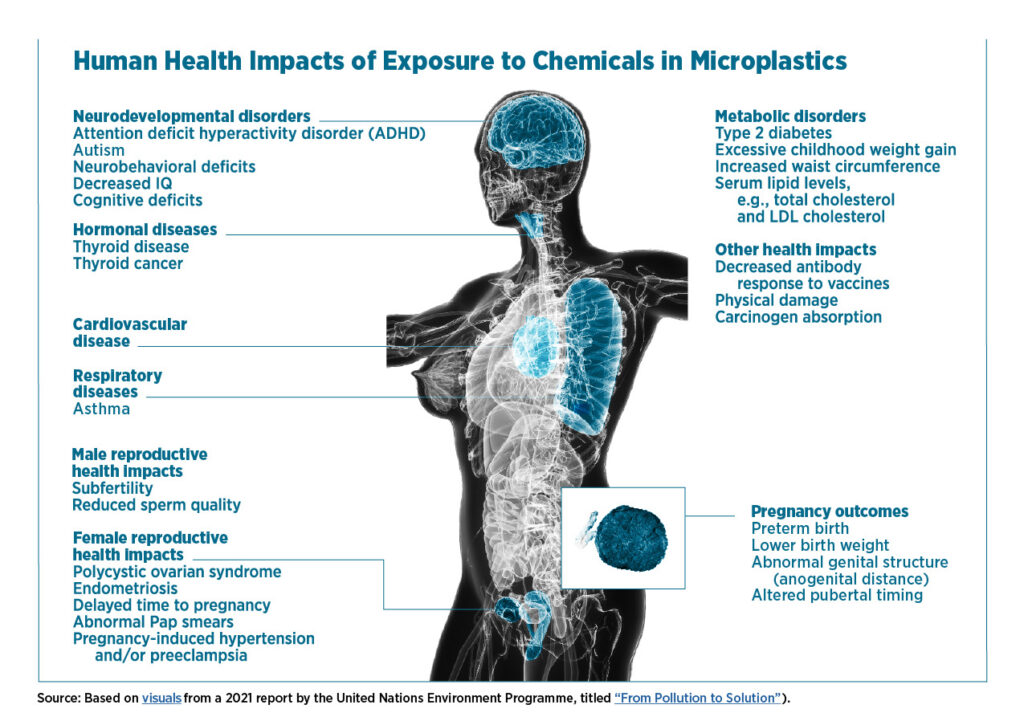As the world’s understanding of the plastics crisis grows, new facets of the problem emerge and reveal impacts on human health and the environment. Recent advances in science are allowing scientists to explore how micro- and nanoplastics form a critical piece of the plastic pollution problem. First thought to be mainly a marine pollution issue, over the last decade, scientists have discovered micro- and nanoplastics exist in every environmental compartment — from freshwater to soil and air — and in thousands of species, including humans.[1] But like climate change and hazardous chemicals, most plastics are invisible to the naked human eye, meaning their impact goes relatively unseen.[2]
Contrary to popular depictions, oceans are not “the final sink”[3] for microplastics. These tiny plastic particles can travel worldwide, ending up in urban, rural, and remote areas. They take an even faster transport pathway than oceanic currents: the atmosphere.[4] Moving through the air, micro- and nanoplastics can cover thousands of kilometers in a matter of days to weeks, creating what could be a “never-ending loop” of plastic transport.[5] The serious potential for long-range transport means that micro- and nanoplastics can affect locations and populations vast distances from the sources of plastic pollution, making microplastics “one of the most ubiquitous pollutants released by anthropogenic activities”[6] and a grave public health issue.[7] While scientists may not yet know the full scope of the health impacts of micro- and nanoplastics, the cause is undeniably clear: the production and use of plastics.
The Problem
Everywhere they look, scientists are finding microplastics.[8] Often so small that they are invisible to the human eye, these tiny plastic particles are imperceptible as they pass through airways and reach the very bottom of the lungs. Scientists have found that inhalation is a major contributor to human intake of micro- and nanoplastics, and exposure rates — the amount of atmospheric micro- and nanoplastics in an individual’s vicinity — can be as high as 5,700 microplastics per cubic meter.[9] It’s estimated that humans can inhale up to 22,000,000 micro- and nanoplastics annually.[10]
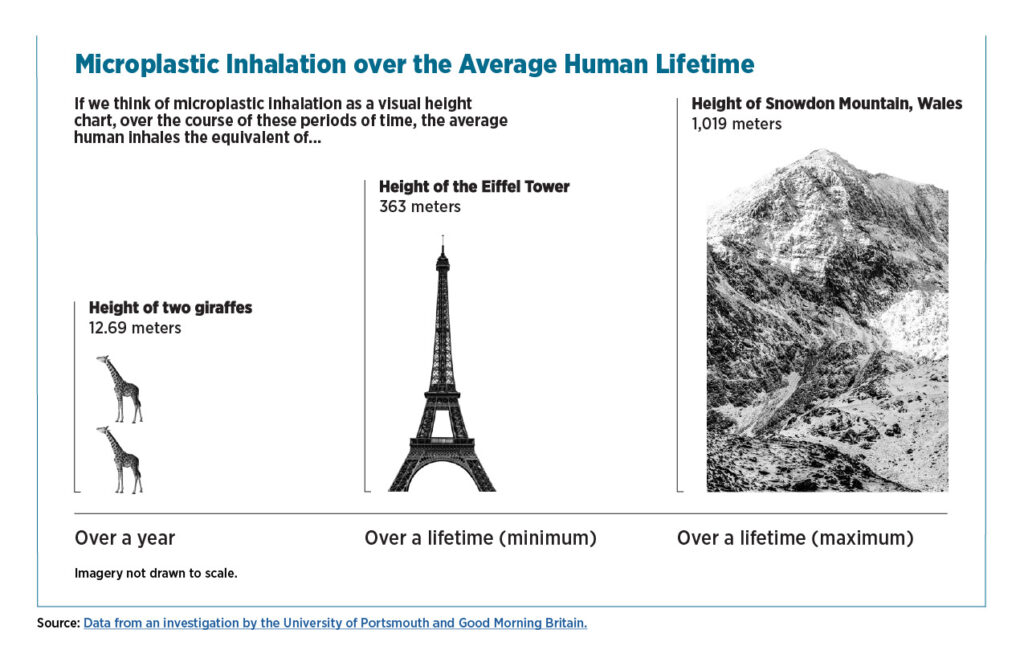
To better understand the issue, it is essential to examine the scales used to classify plastic particles. Microplastics are plastic particles less than 5 millimeters (mm) in diameter, about the size of an orange seed.[11] Airborne microplastics, however, are much smaller — even a 0.5 mm (500 micrometer (µm)) particle is considered large. When plastic fragments are below 0.001 mm in size (equivalent to 1 μm or 1,000 nanometers (nm)), they are less than 1/100th of the thickness of a human hair. Particles this small are called nanoplastics and cannot be seen by the naked eye.[12]
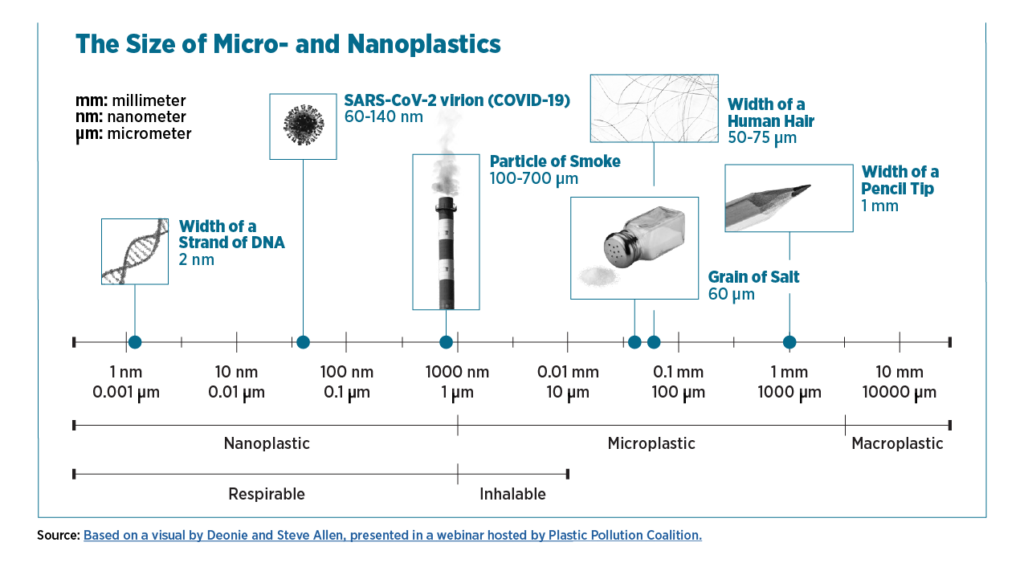
Multiple Sources, Same Origin
Fundamentally, atmospheric microplastics come from human creation and use of plastics. Microplastics fall into categories based on their origin.[13] Primary microplastics[14] are intentionally produced at microscale for a specific use (such as agrochemicals or pharmaceuticals). In contrast, secondary microplastics result from the mechanical, chemical, and physical fragmentation of larger (macro) plastics, which can include “legacy” plastics disposed of in the environment decades ago. Every stage of the plastics life cycle, from the extraction of feedstocks to production, transport, use, disposal, and remediation, emits both primary and secondary microplastics and other hazardous substances.[15]
Moving through Air
Since air is a strong environmental media, the spread and effects of airborne microplastics can remain localized or extend far beyond the point of release. While concentration levels vary, no location remains untouched. Airborne microplastics have been collected worldwide, but especially in the Northern Hemisphere, including France, Iran, China, Japan, Vietnam, Nepal, the United States, Colombia, Saudi Arabia, South Korea, Kuwait, Greece, Romania, Pakistan, and India.[16]
Inside the Body
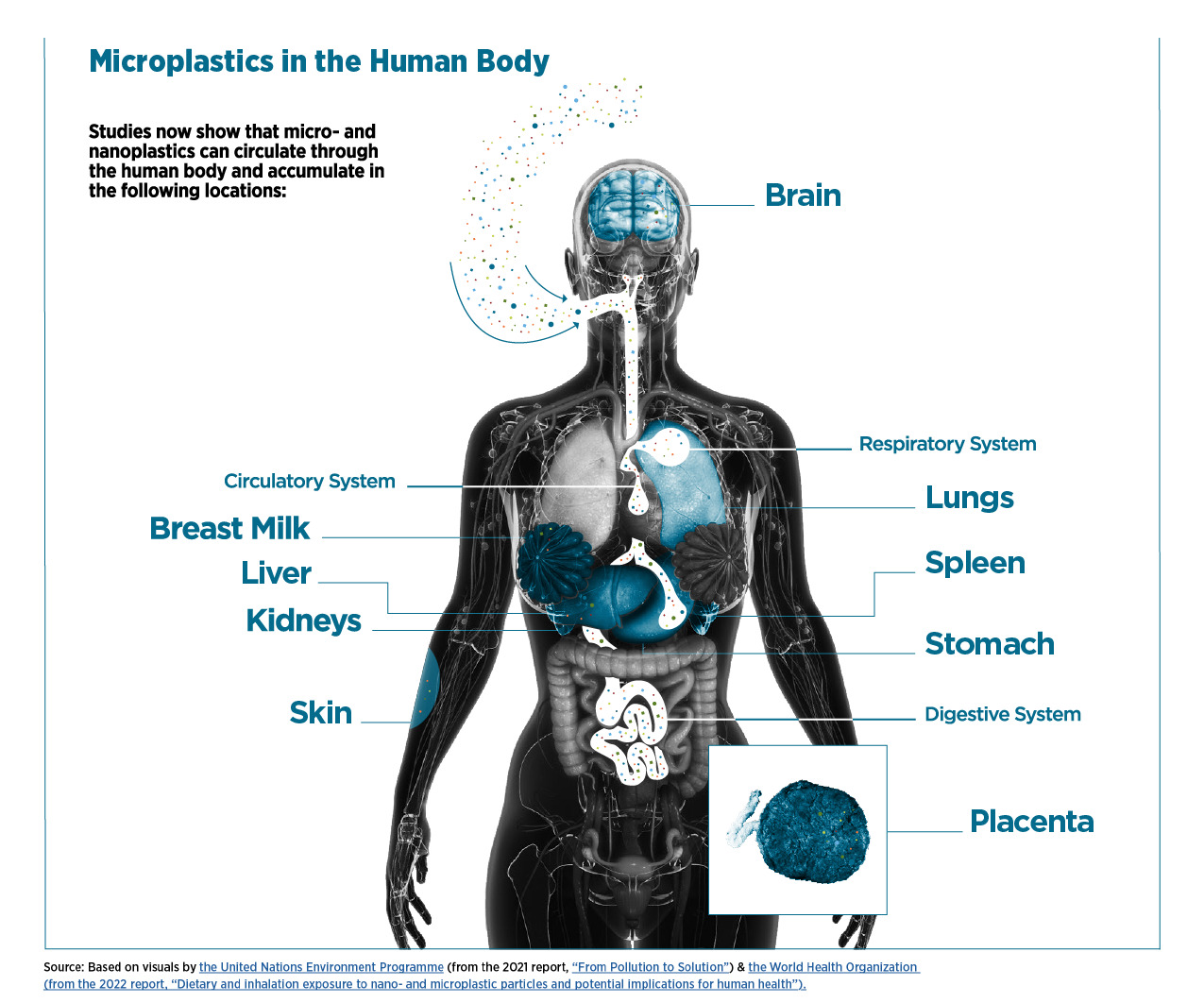
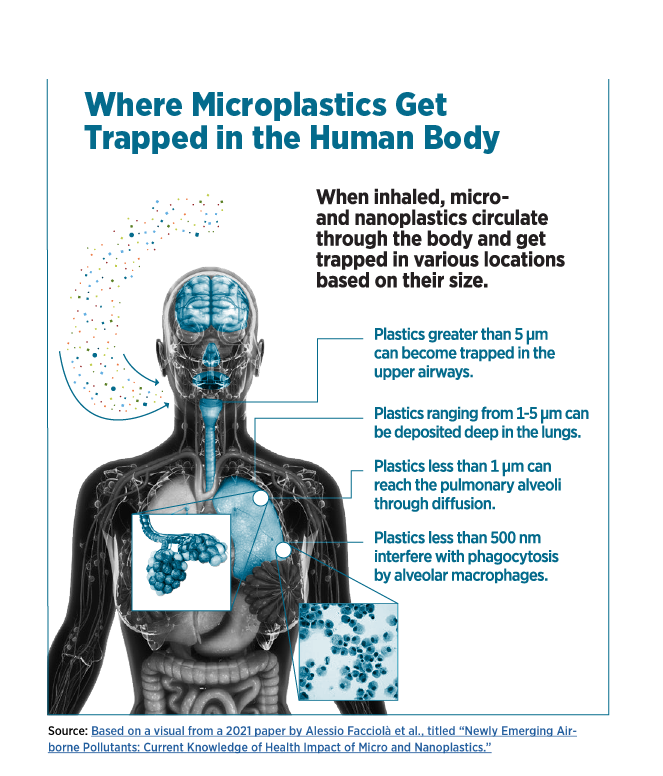
Exposure to airborne microplastics can occur through inhalation, penetration through skin pores, and ingesting foods that contain them.[17] Microplastics’ reach inside the human body depends on their properties, size, shape, and an individual’s metabolism, susceptibility, and lung anatomy.[18] They can enter the respiratory system through the nose or mouth before being deposited in the upper airways or deep in the lungs.[19]
Once there, evidence shows that micro- and nanoplastics can be transferred from the lung epithelial surface to lung tissue,[20] potentially to internal organs and the vascular system,[21] and beyond.
A Trojan Horse
The very characteristics of microplastics reveal their potential to be a dangerously potent vector for toxics and pathogens. Microplastics often have large specific surface areas and are predominantly hydrophobic, meaning they repel water. These characteristics make airborne microplastics a “Trojan Horse” capable of hiding and carrying harmful substances inside the animals or humans who inhale, absorb, and ingest them.[22] Therefore, knowing what’s inside plastic is as important as knowing what lies on it.[23]
Health Impacts
While airborne microplastics research is in its infancy, studies on the inhalation of micro- and nanoparticles of plastics show a series of adverse effects along the respiratory tract and beyond, ranging from irritation to the onset of cancer in cases of chronic exposure.[24] These adverse effects include:
- immediate asthma-like reactions;
- inflammatory reactions and fibrotic changes, like chronic bronchitis;
- lung disorders such as extrinsic allergic alveolitis and chronic pneumonia;
- pulmonary emphysema;[25]
- the development of interstitial lung diseases,[26] resulting in coughing, difficulty breathing, and a reduction in lung capacity;[27]
- oxidative stress and the formation of reactive oxygen species (ROS) and thus the ability to damage cells (cytotoxic effects);[28] and
- autoimmune diseases.[29]
A Toxic Cocktail
Exposure to airborne microplastics is not happening in a vacuum. Humans are exposed to multiple pollutants and hazardous chemicals daily, including microplastics ingested via other sources, such as food or drink. While research on airborne microplastics is in its infancy, microplastic exposure typically happens alongside other toxic substances.
The Bigger Picture
If no action is taken, the volume of airborne microplastic emissions will follow the expected rise in plastic production, resulting in a greater risk of spreading potentially toxic chemicals. Regulators need to dramatically reduce the production of plastics and phase out hazardous chemicals.
Recommendations
- Consider the combined “cocktail” effect. Exposure to micro- and nanoplastics is a multi-faceted problem touching on air, water, terrestrial environments, food, and more. Regardless of how exposure occurs, it typically happens alongside other toxics. Humans are exposed to multiple pollutants and hazardous chemical compounds daily, including endocrine disruptors and POPs linked to diabetes, infertility, and hormone-related cancers. Regulators need to apply the precautionary principle to address the risks of combined exposure. Such an approach should include ensuring access to information on the petrochemical compounds in plastics products and processes (both voluntary and non-intentionally added) for ALL plastic products, not just food-grade plastics.
- Adopt legally binding measures without any further delay. Self-regulation and voluntary approaches have failed to reduce plastic and microplastic pollution. Banning intentionally added microplastics is the first step. Mandatory regulations will need to reduce the production and release of plastic and its associated compounds and reduce human exposure to plastics, microplastics, and nanoplastics.
- Address the full life cycle of plastics. Airborne micro- and nanoplastics are part of the bigger story of plastics. Thus, a systemic effort is needed to address the full issue, beginning with the extraction of fossil fuels and associated chemicals used in plastic production. Decision makers should further support action at the global level, supporting ambitious and effective provisions, including strict enforcement measures in the future international legally binding agreement on plastic that will be negotiated before the end of 2024.
This post is an adapted summary of this issue brief.
Published March 27th, 2023
[1] Steve Allen et al., “Micro(Nano)Plastics Sources, Fate, and Effects: What We Know after Ten Years of Research,” Journal of Hazardous Materials Advances 6 (May 1, 2022): 1, https://doi.org/10.1016/j.hazadv.2022.100057.
[2] Allen et al., 2.
[3] Allen et al., 6.
[4] Allen et al., 6; Deonie Allen et al., “Microplastics and Nanoplastics in the Marine-Atmosphere Environment,” Nature Reviews Earth & Environment 3, no. 6 (June 2022): 393, https://doi.org/10.1038/s43017-022-00292-x.
[5] Allen et al., “Micro(Nano)Plastics Sources, Fate, and Effects,” 6.
[6] Yulan Zhang et al., “Atmospheric Microplastics: A Review on Current Status and Perspectives,” Earth-Science Reviews 203 (April 1, 2020): 11, https://doi.org/10.1016/j.earscirev.2020.103118.
[7] A. Dick Vethaak and Juliette Legler, “Microplastics and Human Health,” Science 371, no. 6530 (February 12, 2021): 672–74, https://doi.org/10.1126/science.abe5041.
[8] “Nanoplastics — an underestimated problem?,” ScienceDaily, accessed November 6, 2021, https://www.sciencedaily.com/releases/2021/05/210504112641.htm; Albert A. Koelmans et al., “Risk Assessment of Microplastic Particles,” Nature Reviews Materials 7, no. 2 (February 2022): 138–52, https://doi.org/10.1038/s41578-021-00411-y.
[9] Yaowei Li et al., “Airborne Fiber Particles: Types, Size and Concentration Observed in Beijing,” Science of The Total Environment 705 (February 25, 2020): 5, https://doi.org/10.1016/j.scitotenv.2019.135967; S. Allen et al., “Evidence of Free Tropospheric and Long-Range Transport of Microplastic at Pic Du Midi Observatory,” Nature Communications 12, no. 1 (December 21, 2021): 5, https://doi.org/10.1038/s41467-021-27454-7; An Xu et al., “Status and Prospects of Atmospheric Microplastics: A Review of Methods, Occurrence, Composition, Source and Health Risks,” Environmental Pollution 303 (June 15, 2022): 5, https://doi.org/10.1016/j.envpol.2022.119173.
[10] Kieran D. Cox et al., “Human Consumption of Microplastics,” Environmental Science & Technology 53, no. 12 (June 18, 2019): 7071, https://doi.org/10.1021/acs.est.9b01517; Kurunthachalam Kannan and Krishnamoorthi Vimalkumar, “A Review of Human Exposure to Microplastics and Insights Into Microplastics as Obesogens,” Frontiers in Endocrinology 12 (2021): 978, https://doi.org/10.3389/fendo.2021.724989; Zhang et al., “Atmospheric Microplastics,” 12; Qun Zhang et al., “A Review of Microplastics in Table Salt, Drinking Water, and Air: Direct Human Exposure,” Environmental Science & Technology 54, no. 7 (April 7, 2020): 3747, https://doi.org/10.1021/acs.est.9b04535; See also Alvise Vianello et al., “Simulating Human Exposure to Indoor Airborne Microplastics Using a Breathing Thermal Manikin,” Scientific Reports 9, no. 1 (June 17, 2019): 8670, https://doi.org/10.1038/s41598-019-45054-w; “World-First Investigation Finds People Are Breathing in 100 Times More Microplastics,” accessed November 12, 2021, https://www.portsmouth.co.uk/news/people/world-first-investigation-by-university-of-portsmouth-and-good-morning-britain-finds-people-are-breathing-in-100-times-more-microplastics-in-homes-than-thought-3449090.
[11] Richard C. Thompson et al., “Lost at Sea: Where Is All the Plastic?,” Science 304, no. 5672 (May 7, 2004): 838–838, https://doi.org/10.1126/science.1094559; C. Arthur, “Proceedings of the International Research Workshop on the Occurrence, Effects and Fate of Microplastic Marine Debris” (University of Washington Tacoma, Tacoma, WA, USA: National Oceanic and Atmospheric Administration (NOAA), 2008), 10; Nanna B. Hartmann et al., “Are We Speaking the Same Language? Recommendations for a Definition and Categorization Framework for Plastic Debris,” Environmental Science & Technology 53, no. 3 (February 5, 2019): 1040, https://doi.org/10.1021/acs.est.8b05297.
[12] Joint Group of Experts on the Scientific Aspects of Marine Environmental Protection (GESAMP), “Proceedings of the GESAMP International Workshop on Assessing the Risks Associated with Plastics and Microplastics in the Marine Environment,” 2020, 26, http://www.gesamp.org/publications/gesamp-international-workshop-on-assessing-the-risks-associated-with-plastics-and-microplastics-in-the-marine-environment.
[13] GESAMP, “Sources, Fate and Effects of Microplastics in the Marine Environment (Part 1),” GESAMP Reports and Studies (International Maritime Organization (IMO), 2015), 18, http://www.gesamp.org/publications/reports-and-studies-no-90.
[14] “Nanoplastics Are Neither Microplastics nor Engineered Nanoparticles | Nature Nanotechnology,” accessed July 16, 2022, https://www.nature.com/articles/s41565-021-00886-4 Figure 2.
[15] Center for International Environmental Law (CIEL) et al., “Plastic & Health: The Hidden Costs of a Plastic Planet,” accessed November 1, 2021, https://www.ciel.org/reports/plastic-health-the-hidden-costs-of-a-plastic-planet-february-2019/.
[16] Junjie Zhang, Lei Wang, and Kurunthachalam Kannan, “Microplastics in House Dust from 12 Countries and Associated Human Exposure,” Environment International 134 (January 1, 2020): 105314, https://doi.org/10.1016/j.envint.2019.105314; Wang et al., “Airborne Microplastics,” 657.
[17] Christian Ebere Enyoh et al., “Airborne Microplastics: A Review Study on Method for Analysis, Occurrence, Movement and Risks,” Environmental Monitoring and Assessment 191, no. 11 (October 24, 2019), https://doi.org/10.1007/s10661-019-7842-0.
[18] Enyoh et al., “Airborne Microplastics.”
[19] Johnny Gasperi et al., “Microplastics in Air: Are We Breathing It In?,” Current Opinion in Environmental Science & Health, Micro and Nanoplastics Edited by Dr. Teresa A.P. Rocha-Santos, 1 (February 1, 2018): 3, https://doi.org/10.1016/j.coesh.2017.10.002; Joanne M. Donkers et al., “Advanced Epithelial Lung and Gut Barrier Models Demonstrate Passage of Microplastic Particles,” Microplastics and Nanoplastics 2, no. 1 (January 28, 2022): 2, https://doi.org/10.1186/s43591-021-00024-w.
[20] J. L. Pauly et al., “Inhaled Cellulosic and Plastic Fibers Found in Human Lung Tissue.,” Cancer Epidemiology and Prevention Biomarkers 7, no. 5 (May 1, 1998): 425, https://cebp.aacrjournals.org/content/7/5/419.
[21] Heather A. Leslie et al., “Discovery and Quantification of Plastic Particle Pollution in Human Blood,” Environment International, March 24, 2022, 5–7, https://doi.org/10.1016/j.envint.2022.107199.
[22] Yi Wang et al., “Airborne Microplastics: A Review on the Occurrence, Migration and Risks to Humans,” Bulletin of Environmental Contamination and Toxicology 107, no. 4 (October 2021): 662, https://doi.org/10.1007/s00128-021-03180-0; Jacky Bhagat, Norihiro Nishimura, and Yasuhito Shimada, “Toxicological Interactions of Microplastics/Nanoplastics and Environmental Contaminants: Current Knowledge and Future Perspectives,” Journal of Hazardous Materials 405 (March 5, 2021): 4, https://doi.org/10.1016/j.jhazmat.2020.123913.
[23] Koelmans et al., “Risk Assessment of Microplastic Particles,” 3.
[24] Alessio Facciolà et al., “Newly Emerging Airborne Pollutants: Current Knowledge of Health Impact of Micro and Nanoplastics,” International Journal of Environmental Research and Public Health 18, no. 6 (January 2021): 7, https://doi.org/10.3390/ijerph18062997.
[25] Facciolà et al., “Newly Emerging Airborne Pollutants,” 9.
[26] Luís Fernando Amato-Lourenço et al., “An Emerging Class of Air Pollutants: Potential Effects of Microplastics to Respiratory Human Health?,” Science of The Total Environment 749 (December 20, 2020), https://doi.org/10.1016/j.scitotenv.2020.141676
[27] Gasperi et al., “Microplastics in Air,” 3.
[28] Amato-Lourenço et al., “An Emerging Class of Air Pollutants.”
[29] Facciolà et al., “Newly Emerging Airborne Pollutants,” 7.

